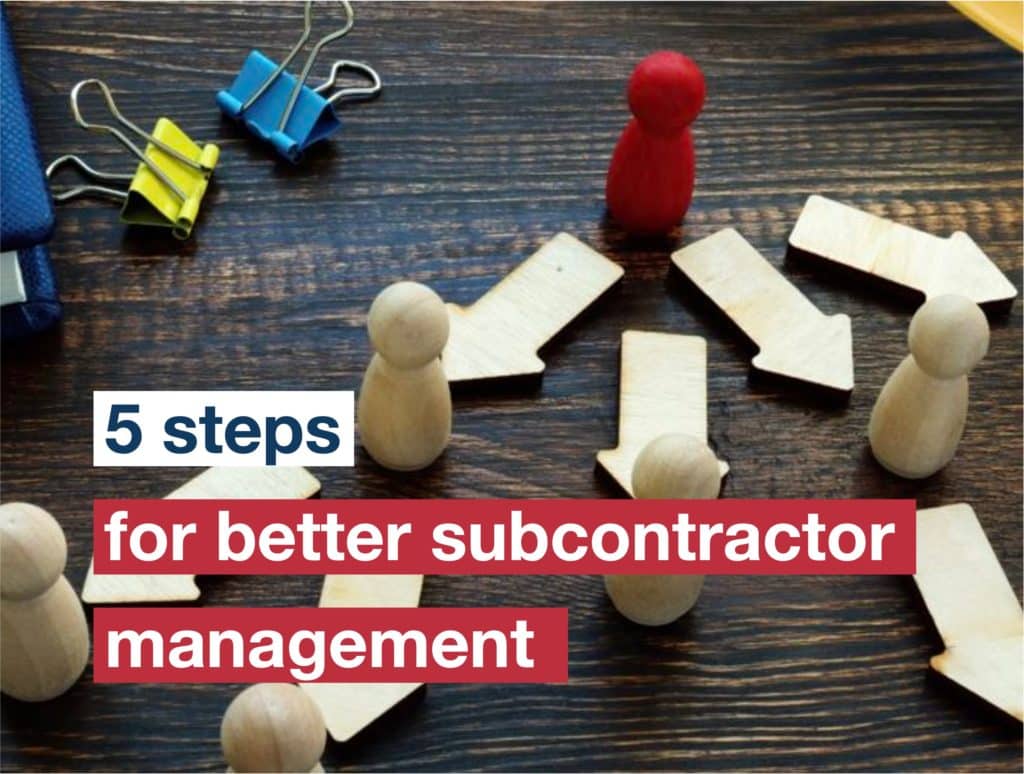
In some sectors, such as construction or civil engineering, the use of subcontracted labour is commonplace. Subcontracting allows companies to strengthen their workforce, but it is not without risks. To ensure that the collaboration runs smoothly, there are rules to follow.
What is subcontracting?
Subcontracting is a contract between two companies, namely the principal and the subcontractor. The first, called the principal, decides to entrust to a second company, called the subcontractor, all or part of the execution of the work to be carried out for a client. The customer is commonly called the client.
The contractor remains responsible for the project to the client. This is why the choice of the subcontracting company is essential, to ensure the quality of the work provided and the respect of the legislation.
What is subcontractor management?
The subcontractor does not deal directly with the client, or project owner. It reports directly and solely to the client company.
It is therefore the responsibility of the latter to provide the subcontractor with clear and detailed specifications, as well as to oversee the work in progress.
Managing subcontractors can be divided in 4 phases :
- Defining the project’s scope and putting out sending requests to potential subcontractors.
- Reviewing proposal and bids from subcontractors, choose the right partner and precise the contract details.
- Monitoring the operations and day-to-day work of subcontractors, ensuring quality standards are met.
- Inspecting the work done and requesting change order if the result isn’t sufficient.
When managing subcontractors, giving clear specifications up front will help you avoid any change orders later on.
These specifications include the guidelines and technical specifications necessary for the execution of the contract. On the basis of the specifications, the subcontractor then provides an execution schedule, allowing to organize the execution of the entrusted work.
In France, the definition of subcontracting is clearly defined by the law, which defines the precise conditions. For example, it is mandatory to have at least two separate contracts: the one between the client and the principal on the one hand, and the one between the principal and the “contractor” or subcontractor on the other hand.
What is a subcontract?
A subcontract is a contract document between two parties:
- The contractor, or the main company having won the contract for the execution of the work for the client
- The subcontractor, or the company “taking the order”, which is entrusted with all or part of the actual execution of the work
The subcontracting contract clearly defines the missions, or services, which will be entrusted to the subcontracting company.
Contrary to an employment contract, there is no subordination link between the ordering company and its subcontractor. The two entities are only linked by the execution of the mission.
Why subcontracting in the building sector ?
The advantages of subcontracting
Subcontracting offers great flexibility in the amount of labor to be paid. When a general contractor is selected in a tender for a large project, subcontracting allows him to benefit from an immediate reinforcement of his work force.
Once the project is closed, the general contractor can go back to operating on the basis of its own staff. The main advantage of subcontracting is therefore the ability to immediately compensate for a lack of manpower.
In view of the current talent shortage in the construction sector, the use of subcontracting has increased particularly in recent years.
The risks of subcontracting
Unfortunately, using subcontracted personnel carries risks:
- Poor quality of the work produced
- Lack of respect for safety measures
- Non-compliance of the personnel (illegal work, lack of qualification…)
- Lack of view on the real productivity of the subcontractors hired
These risks can be greatly reduced thanks to a good management of the subcontracting: from the choice of the partner to the supervision of the new workers, nothing should be left to chance.
How to manage subcontractors effectively? The 5 best practises.
Managing subcontractors raises specific challenges. To properly manage a subcontracted workforce, good organization is key. Fortunately, there are a multitude of tools adapted to help you in this task.
All these tools help you to respect the 5 rules for a good management of subcontracting in the construction industry.
1. Plan and define the needs in subcontracting
Before calling upon a subcontractor, it is essential to evaluate the need for additional manpower.
For this, it is crucial to have correctly planned your own workforce. Having an accurate view of the availability of your own staff is the first step, allowing you to evaluate the shortage to be filled.
Once the planning of the site teams is established, it becomes easier to compare the available forces with the manpower required for the realization of the project, and thus to define its needs in subcontracting.
2. Choosing the right outsourcing company
It goes without saying, but choosing a partner is a crucial step in the success of the collaboration.
Take the time to learn about the candidate company: does it have a reputation for doing good work? Does it use qualified personnel hired under a legal employment contract? Are its workers trained in safety standards?
In the construction industry in particular, you should be especially careful.
Find out about :
- Its qualifications
- The compliance of its personnel
- The respect of the safety measures
When looking for the right subcontractors, the specialized skills of the potential partner are one of the first things to consider. However, that’s not all. To avoid potential problems, it’s important to be informed about the subcontractor’s past performance or past problems. Have they had compliance issues in the past?
Finally, establishing clear communication from the start will help avoid many problems later on.
3. Follow the regulations
It is the responsibility of the general contractor to ensure compliance with the legislation and regulations in force, under penalty of heavy sanctions.
Among the regulatory obligations to be respected:
- Establish the work contract
- Provide the tools necessary for the job
- Ensure the legal compliance of workers: work permits, specific qualifications…
- Supervise the staff and ensure compliance with safety standards
In Belgium and Spain, for example, it is now mandatory to declare the presence of workers to the social security system on a daily basis for most construction sites. The general contractor is obliged to provide a suitable attendance recording tool.
4. Establish a solid process
Any subcontracting process must follow a clear and precise procedure. Each step is essential.
General steps :
- Definition of subcontracting needs
- Choice of the partner company
- Establishment of the contract of treatment
- Control of the administrative conformity for each worker
- Reception of the workers on the site
- Supervision of the workers throughout the course of the project
In addition to the right choice of partner, one step is crucial here. It is to ensure the legal compliance of each subcontracted worker. A missing or invalid document, and it is a heavy penalty that awaits both the general and subcontracting company.
Also, be sure to designate project managers to oversee the various phases of the project. Throughout the project and phases, good communication will be essential.
5. Choose the right tools & software
Outsourcing raises specific challenges: ensuring safety, compliance or even worker productivity… in order to make the collaboration a success, it must be properly managed.
When you can’t possibly be everywhere at the same time, digital technology can help you make sure everything is properly monitored.
But how do you choose the right software for your business? They are a few important criteria to keep in mind.
Be especially careful to choose software that is :
- Specialized in your industry: the construction industry is complex and has inherent challenges
- Flexible: best-in-class software must be configurable to fit your company’s processes perfectly
- Easy-to-use: tools that are not user-friendly are simply not used by teams.
- Scalable: today or in 10 years, your company’s needs may not be the same
4 tips for easier subcontractor management with digital technology
1. Manage subcontractors’ document within a collaborative platform
One of the most tedious tasks when using subcontractors is to keep track of the administrative order of each worker.
This is because the prime contractor, or main company, is still responsible for the job site and therefore for the compliance of all workers on the job site.
Previously managed by hand using a multitude of folders, the workers’ documents can now be centralized within a single platform.
The DocXchange management platform developed by Traxxeo allows to collect and track the administrative documents of subcontracted workers with ease. Technologies such as artificial intelligence and the cloud help managers to manage this administrative process with ease.
The implementation of DocXchange allows the automation of many operations incumbent upon the principal, such as the collection, verification and follow-up of all administrative documents of the workers.
2. Monitor site attendance with a flexible system
When managing subcontracted workers, another challenge is to track their presence and movements on the job site.
Who is where, when? From the field, site managers sometimes operate in a state of limbo. Yet, getting a clear view of presence is critical and can save lives in the event of an accident.
Traxxeo’s Presence Control solution provides a clear view of the presence on site, at any time. Site personnel easily declare any new worker on their smartphone. Central managers get the information immediately.
In some countries, such as Belgium or Spain, where attendance registration is mandatory in some cases, the system also communicates with the social security system, in order to declare daily attendance on site.
3. Ensure worker compliance through a mobile application
In a subcontracting contract, the main company remains responsible for the legal compliance of the site and therefore of its workers.
However, when this is managed manually, it is often very difficult to get a clear view of the administrative order of the worker who shows up on the site. Indeed, the control of the administrative order is a time-consuming and difficult operation when you are in the field.
With Presence Control from Traxxeo, the information is directly visible on a mobile application. The data is constantly updated. The app also allows you to welcome a new worker and make him/her compliant, directly from the field.
4. Secure your worksite with a flexible access control system
Beside compliance issues, a digital system such as Access Control enables efficient access management based on up-to-date data. This ensures the security of your work site, allowing only trained and authorized personnel to enter.
Combining the right hardware with a powerful and flexible access control software, Traxxeo’s Access control solution allows for optimal security for all workers on their jobsite.
Simplify your subcontracting management with Traxxeo
Using subcontracted labor can be a very effective strategy to gain flexibility and temporarily reinforce your workforce.
To help you in this process, and to avoid taking risks, Traxxeo has developed a series of software solutions dedicated to subcontractors management.
Are you concerned? Let’s see how digital technology can help you better manage your subcontractors.
Simplify your subcontracting management
